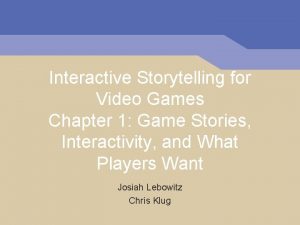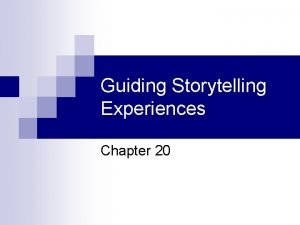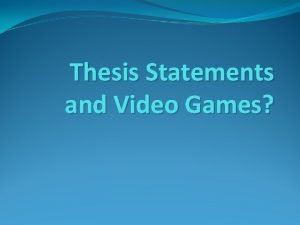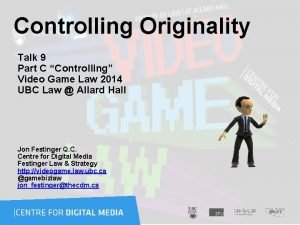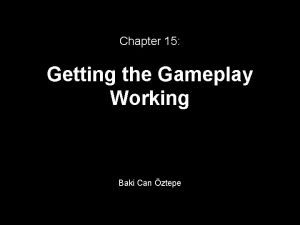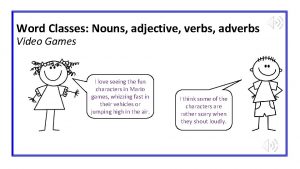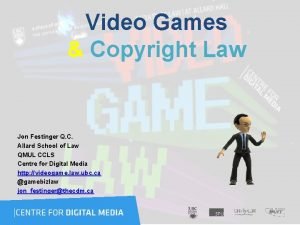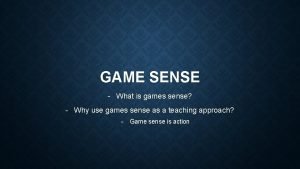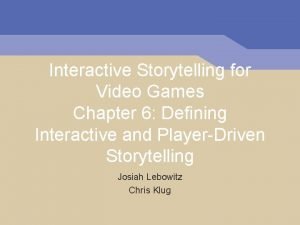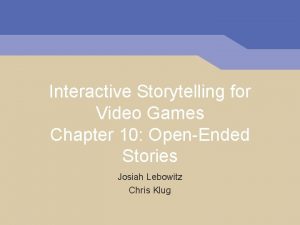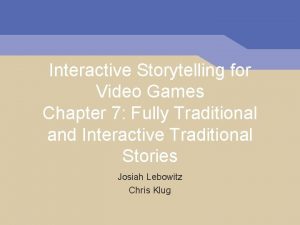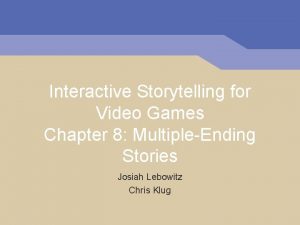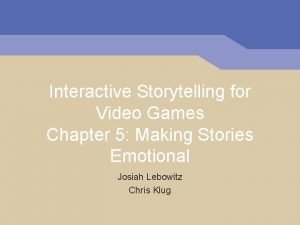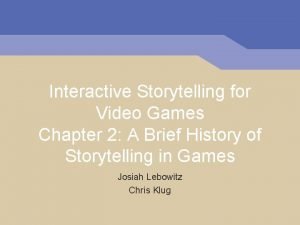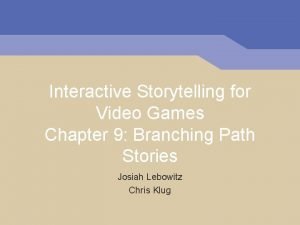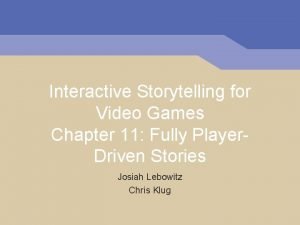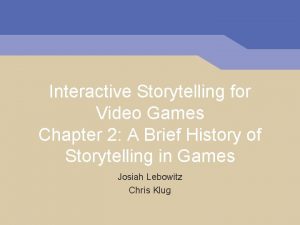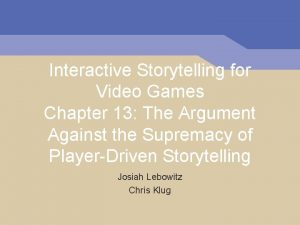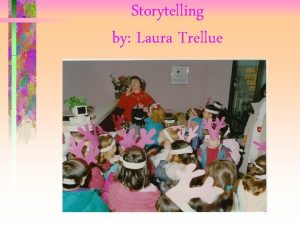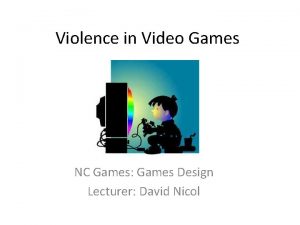Interactive Storytelling for Video Games Chapter 4 The





















- Slides: 21

Interactive Storytelling for Video Games Chapter 4: The Story and Characters Josiah Lebowitz Chris Klug

Story Flow and Pacing § Pacing or flow is the way the story moves between big fast moving sections and small slower moving sections. § Without enough slower paced sections the player won’t have time to take things in and will get worn out. § Without enough fast paced sections the story can seem dull and boring. § A good balance is needed.

Keeping the Player Engaged § It’s tempting to jump from big scene to big scene, but smaller low key scenes are needed to develop the characters and setting. § If players don’t care about the characters or setting, they won’t care much about what happens to them regardless of how shocking or epic the scene is. § Placing story scenes (big and small) regularly throughout the game helps keep players interested in plot.

General Pacing Do’s and Don’ts § DO space big plot twists and epic scenes evenly throughout the story. § DO leave space for slower scenes. § DO analyze the pacing in popular stories as a guide. § DON’T make stories all action all the time. § DON’T let slower sections drag on for too long. § DON’T fill sections with pointless chatter or busywork. § DON’T save all the big reveals for a single part of the story. § DON’T add unnecessary scenes to “even out” the pacing.

Character Archetypes § An archetype is a general character template that can be customized to fit any story. § Archetypes are like characters classes. § There are hundreds of different archetypes. § While two characters of the same archetype will have some similarities, they can still be highly unique.

Common Archetypes § Young Hero: Cheerful, enthusiastic, and helpful like Sora (KINGDOM HEARTS). § Reluctant Hero: Selfish, lazy, and rude like Neku (THE WORLD ENDS WITH YOU). § Best Friend: Supportive and a good balance to the hero like Max (Sam & Max).

Common Archetypes § Special Person: Mysterious, alone, and possessing special power like Aerith (FINAL FANTASY VII). § Mentor: Wise and experienced like The Boss (Metal Gear Solid 3). § Veteran: A hardened warrior like Shepard (Mass Effect). § Gambler: Sees life as a game like Mion (Higurashi).

Common Archetypes § Seductress: Beautiful, confident, and merciless like Echidna (THE BOUNCER). § Hardened Criminal: Comfortable in a life of crime like Niko (GTA IV). § Cold Calculating Villain: Ruthlessly works towards a complex master plan like Primarch Dysley (FINAL FANTASY XIII).

Advantages and Disadvantages of Archetypes § They can provide a good starting point. § They help you create characters with consistent thoughts, actions, and personalities. § They help players easily identify with characters. § Characters that stick too closely to an archetypical role can easily become predictable and cliché. § Archetypes can be restrictive and prevent characters from growing and evolving as the story progresses.

KINGDOM HEARTS II § Released by Square Enix in 2006 (PS 2). § Mixes Disney and FINAL FANTASY. § Disney characters all fall into clear archetypical roles. § They remain interesting and entertaining thanks to well crafted and believable personalities. § Many characters’ personalities are far more complex than they first appear.

Making Characters Believable § If a character acts in a an unrealistic way, players will have trouble connecting with and growing attached to him. § Unrealistic behavior refers to the character’s speech, personality, and actions; not any impossible powers or technology he may have. § Once you know a bit about a character’s background and personality, it often become fairly easy to predict how he’ll react to various situations. If he doesn’t act the way he should, he loses believability.

How Characters Act § When making any decisions, characters will consider numerous factors and come to a decision based on their desires, personalities, and beliefs. § Unless there are serious extenuating circumstances, characters shouldn’t act against their defined desires, personalities, and beliefs. § When forced to do something against their will, or facing a highly traumatic event, it’s important that characters show the appropriate emotions, rather than taking everything in stride. § Characters can change, but they should do so gradually over time.

How Characters Speak § A character’s speech should reflect their nationality, personality, and upbringing. § An orphan from the streets of New York City will have vastly different speech patterns than a Japanese businessman, even when they’re both speaking English. § Characters from other countries or worlds shouldn’t use American English idioms and expressions.

FINAL FANTASY XIII § Released by Square Enix in 2010 (PS 3 & 360). § Characters initially seem to fit standard archetypes but have enormous depth and change significantly over the course of the story. § Characters always speak and act in a fully believable manner.

The Importance of Backstory § Characters and worlds have a long and rich history, much of which isn’t very important to the main plot. § Backstory can and should be used to shape your world and characters, even if it doesn’t appear in the game itself. § If the world and characters are well designed, there will always be players eager to learn more about the backstory. § Writing backstory takes time and effort that could be spent on elements more relevant to the main plot so it’s important to carefully budget you time.

How to Tell Backstory § In game books, data discs, etc can provide backstory on a wide variety of elements while giving the player something to search for during the game. § An in-game database makes it easy for players to read and review the backstory at any time. § Snippets of backstory can be revealed in optional conversations. § Some games such as FINAL FANTASY TACTICS and Earth and Beyond use very unique and creative ways to tell backstory.

FINAL FANTASY TACTICS: THE WAR OF THE LIONS § Released by Square Enix in 2007 (PSP) as an enhanced port of the PS original. § Tells its backstory in several different ways. § Optional conversations contain information about local events and history. § An in-game database contains detailed biographies of every character. § Optional quests yield uncover ancient ruins and treasures from the world’s past. § Books contain visual novel games focusing on famous historical characters (Japanese version only).

Leaving Some Mysteries § At times, stories can create a greater impact by leaving some questions unanswered. § Players need to be given enough information to form a reasonable guess (right or wrong) about any lingering questions. § You need to think carefully about which questions can be left unanswered without seriously annoying players.

Shadow of the Colossus § Released by Team Ico in 2008 (PS 2). § Focuses on Wanderer’s quest to save a dead girl. § The story of Wander’s quest and its ultimate outcome is told in full. § The details about his relationship with the girl and the origins of Dormin and the Colossi remained a mystery, leading to considerable speculation among fans.

Braid § Released by Jonathan Blow in 2005 (360, PC, PS 3). § The story is told through snippets of text filled with allusions and metaphors as Tim searches for his lost princess. § More questions are raised than answered. § The story has multiple interpretations, leaving the player to come to his own conclusions.

Things to Consider § Think of a game you’ve played which had poor pacing and identify the problem sections. § Pick a game you’ve played recently and try to figure out which archetype each main character belongs to. Do they follow that archetype for the entire story or do they change partway through? § Think of a game character that behaves in an unbelievable way. What do they do or don’t do that makes them seem unbelievable or unrealistic? § Of all the games you’ve played, which had the most creative or interesting way of telling its backstory? What made it stand out? § Do you prefer games that answer every question or ones that leave some mysteries for you to think about? Why do you prefer that style?
 Interactive storytelling for video games
Interactive storytelling for video games Digital storytelling examples
Digital storytelling examples Interactive capacity games
Interactive capacity games Chapter 20 guiding storytelling experiences
Chapter 20 guiding storytelling experiences What is the physical condition of peeta and katniss?
What is the physical condition of peeta and katniss? Types of games indoor and outdoor
Types of games indoor and outdoor Thesis statement about gaming
Thesis statement about gaming Originality in video games
Originality in video games Columbine shooting and video games
Columbine shooting and video games Is valve a private company
Is valve a private company My.com video games
My.com video games Baki video games
Baki video games Adjectives for video games
Adjectives for video games Santos
Santos Hevga
Hevga Capstone video games
Capstone video games Capstone video games
Capstone video games Video games
Video games Video games that teach history
Video games that teach history Linha do tempo dos videogames
Linha do tempo dos videogames What is gamesense
What is gamesense Heather purdin
Heather purdin
